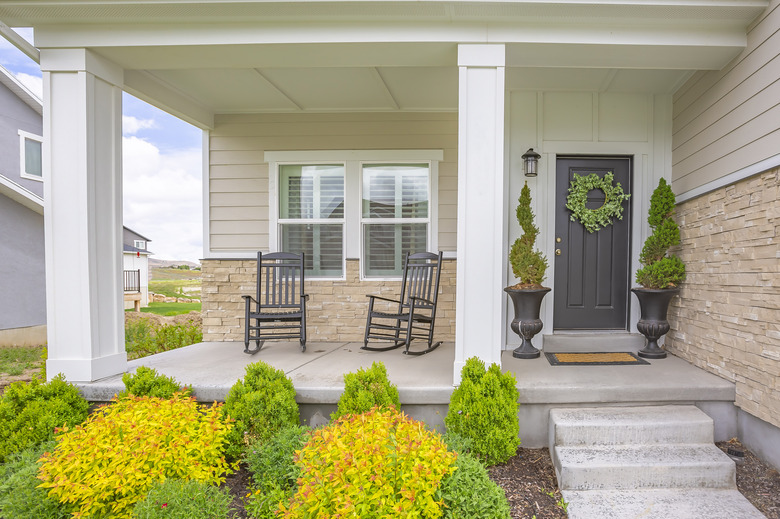Common Repairs Needed After A Home Inspection
A home inspection is not necessarily a mandatory part of the home purchasing process, but most buyers request one, and in some cases, lenders do require it, so it's common. The buyer pays for the home inspection and depending on the contract terms can use the information as a negotiation tool. The home inspection report details problems that render the property unsafe or unhabitable and are in need of repair. No repairs are mandatory, and all items noted in the inspection report are subject to negotiation. Lenders often balk at financing unsafe properties, however, and loss of financing is usually a fatal blow to the purchase agreement.
The home inspection occurs during the due diligence period between signing the purchase agreement and closing, and some state contracts provide a deadline. In California, for example, the home inspection must be completed and repair requests submitted 17 days after ratification of the purchase agreement unless otherwise specified. If unfavorable items turn up that can't be resolved and the sale is contingent on the inspection, as most are, then the buyer can walk away. Rather than doing that, most buyers weigh the unfavorable items in the report against the desirability of the property as a whole and seek modifications to the purchase agreement.
A home inspector is an impartial pro and always finds problems, some of them more serious than others, and it's up to the buyer (and sometimes the mortgage lender) to decide whether or not they are serious enough to warrant a repair request. In a buyer's market in which homes take a long time to sell, the seller will probably agree to make the repairs, but in a hot seller's market, there's less motivation to do expensive repairs because it won't be long before another offer comes in. This renders a buyer's decision of whether or not to make repair requests a strategic decision that must always be made with an eye on the current market trends.
A Home Inspection Prioritizes Safety
A Home Inspection Prioritizes Safety
Top on the list of the items for which home inspectors look are those that are safety concerns. They could be building code violations in the electrical, HVAC or plumbing systems, deterioration in the building structure caused by water damage or a pest infestation or problems inherent with older homes, such as asbestos insulation, lead paint or outdated wiring. There may also be major issues with the property itself, such as overhanging tree branches, dead trees or erosion. Some of the most common safety problems include:
- Electrical hazards: The home inspector will note electrical issues, such as frayed wires, unsafe wiring and worn-out receptacles and switches. The inspection report will also note code violations, such as improper wire size, exposed wires spliced together with tape and undersized or outdated electrical panels. Older houses may have ungrounded wiring, or the wiring methods may be obsolete.
- Structural damage: Of particular interest to inspectors are structural problems that create immediate hazards, such as missing decking boards, floors that are spongy and rotten, cracked and crumbling foundation walls, shaky staircases and broken handrails. They will also note cosmetic problems that indicate underlying structural defects, such as cracks in walls, sticking doors and windows and sloped floors.
- Insufficient fire protection: The inspection report details whether the property has smoke alarms and carbon monoxide detectors in all the right places and whether or not they're working. If they aren't, it's up to the seller to correct the situation, but it's usually a relatively easy problem to fix.
- Mold: Inspectors look for signs of water damage that may be caused by plumbing problems or structural leaks and will note any mold they find. Mold can also grow in improperly maintained air ducts and other HVAC equipment. Mold can potentially be a health hazard and only gets worse if it's not addressed.
- Toxic materials: In older homes, inspectors are on the lookout for asbestos, which may be in the insulation, flooring or siding. They will also look for lead paint, which was commonly used in home interiors before being banned in 1978. The inspector may cite the possible presence of radon, which is a safety concern because it causes lung cancer. If any of these are noted in the report, there may be a follow-up inspection by a specialist.
- Tripping hazards: Inside the house, such conditions as uneven floors, raised thresholds and loose carpeting on stairways create tripping hazards, and others, such as slick bathroom floors, create slipping hazards. Outdoors, protruding tree roots or missing walkway pavers can also be unsafe and are duly noted as such.
The Home Inspection Also Looks at Habitability
The Home Inspection Also Looks at Habitability
Some defects don't necessarily create unsafe conditions, but they affect the livability of the home. The appliances are a case in point, and the inspector will usually check the major ones, such as the furnace. central air system, refrigerator, stove, dishwasher and built-in microwave. Some other common repairs that affect the comfort of the home and that the inspector will note in the report include:
- Leaking or missing gutters and missing roof shingles: Leaking gutters can create hazardous conditions in the winter when water forms icicles or drips onto walkways and freezes. Missing shingles not only look bad but they can be responsible for leaks.
- Doors or windows that stick or are inoperable: Swinging doors may have warped because of changing humidity, sliding doors may have damaged rollers and windows may be painted shut.
- Overgrown or poorly maintained walkways: Pavers may be missing, concrete may be cracked and weeds may be hiding the walkways altogether. Sometimes, tree roots have grown into the walkways and have lifted the concrete.
- Slow-draining plumbing or septic odors: Mild odors are annoying but may be due only to an overfull septic tank, so the problem is easily solved. Strong odors can point to the need for extensive (and expensive) plumbing repairs.
- Electrical problems that may be code violations but don't create immediate hazards, such as missing GFCI outlets or faulty light fixtures: Current codes require GFCIs in the kitchen, bathroom, laundry room, basement, garage and all outdoor locations. Malfunctioning light fixtures need to be replaced.
Some Problems Point to Future Repairs
Some Problems Point to Future Repairs
Besides problems that require immediate repair, the home inspector also notes problems that will need to be repaired in the future. Many code violations fall into this category because when codes change, existing installations are typically grandfathered in and need to be updated only if the house is remodeled. Some indications of expensive repairs down the road include:
- Roof and gutter problems: The roof may be sagging or debris may be collecting in a valley, and both foreshadow future leaks. The ground immediately around the house may be soggy, indicating the need for drainage improvements to prevent foundation damage.
- Termite damage: The inspector doesn't do a complete pest inspection but will note obvious signs of damage from termites or carpenter ants. Left untreated, pests cause extensive damage, so a detailed pest inspection report is usually necessary. Even if the damage isn't extensive, something needs to be done now to control the infestation.
- Outdated or improperly installed plumbing: The house may have galvanized steel plumbing pipes, which will eventually corrode and leak, or some of the pipes may be incorrectly sized. If the inspector notes water spots on the walls or ceiling, that means the problem is acute and needs immediate attention.
- Poor lighting in stairwells or entryways: This is actually a safety hazard, but some people may choose to live with it for the time being. At some point, however, it will have to be updated in the interest of both security and convenience.
Does the Seller Have to Make Repairs?
Does the Seller Have to Make Repairs?
Sellers always have the option of exiting the purchase agreement if they don't want to make repairs requested by buyers, so in this sense, there's no such thing as a mandatory repair. However, state building codes may intervene, especially if part of the property is under construction at the time of the sale. In addition, some states, including California and Massachusetts, require that smoke alarms and carbon monoxide detectors be in place and in good working condition before a house can be sold.
Because they have a financial interest in the property, lenders will also often require certain repairs before approving a mortgage. These are typically the ones most likely to create hazardous conditions, such as structural, plumbing and electrical problems in need of immediate repair. If the lender balks at signing off and the seller refuses to make repairs, the buyer always has the option to shop for a new lender, but more often than not, the deal is dead unless the buyer agrees to do the repairs, which would be highly unusual. In such a situation, the most graceful way out is usually for the buyer and seller to split the costs.
Negotiating Repairs After the Inspection Report
Negotiating Repairs After the Inspection Report
Once the report comes in, the homebuyer gets together with the representing real estate agent to make a list of repair requests to present to the seller. Considering that every homebuyer is entitled to move into a new home that is safe and comfortable, it's usually the seller's responsibility to handle major repairs that affect safety and habitability, and many will do this even before putting the house on the market. Buyers and sellers alike typically overlook purely cosmetic issues, such as peeling paint or dents in the drywall that can be easily handled after the buyer takes possession of the property. A homebuyer who really wants a property risks having the deal fall through by sweating the small stuff.
The seller and the listing agent go over the list and typically make a counteroffer, which may be an agreement to complete all the repairs by closing or by an agreed-upon date after closing. It's also common for the seller to get an estimate for the work and offer the buyer a credit for that amount at closing. If the repair requests are extensive, the seller also has the option to lower the price, but if the market is robust enough and the property sufficiently valuable, it may be more advantageous for the seller to call off the deal at this point and wait for another offer.
A common tactic for a seller who wants the deal to go through and can't afford to make the requested repairs is to offer something of value as a trade. This is often a good opportunity to get rid of an oversized pool table in the basement, the hot tub that's too big and clumsy to move or the RV that you haven't used for three years. Another option is to offer to pay for a home warranty that covers issues that arise for an agreed-upon period of time.
References
- Allen Tate Realtors: Requesting Repairs After a Home Inspection: What's Acceptable and What's Not?
- California Real Estate Inspection Association: Inspection FAQs
- HomeLight: 12 Of the Most Common Repairs Needed After a Home Inspection
- Ownerly: Common Repairs Needed After a Home Inspection
- Zillow: Bad Home Inspection for Sellers: Common Causes and Reasonable Repairs
- Raleigh Realty: 7 Major Home Inspection Issues {2020}


